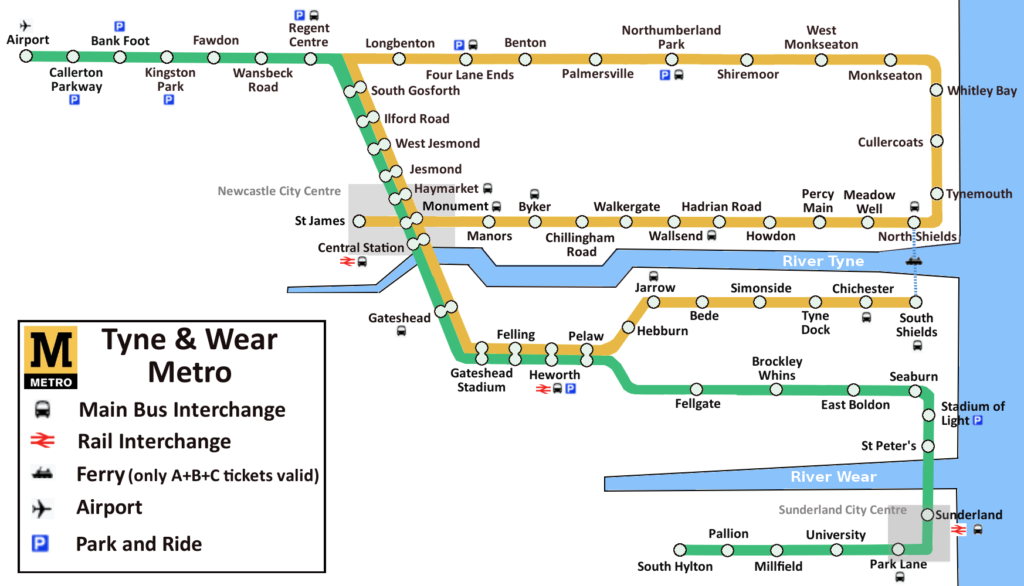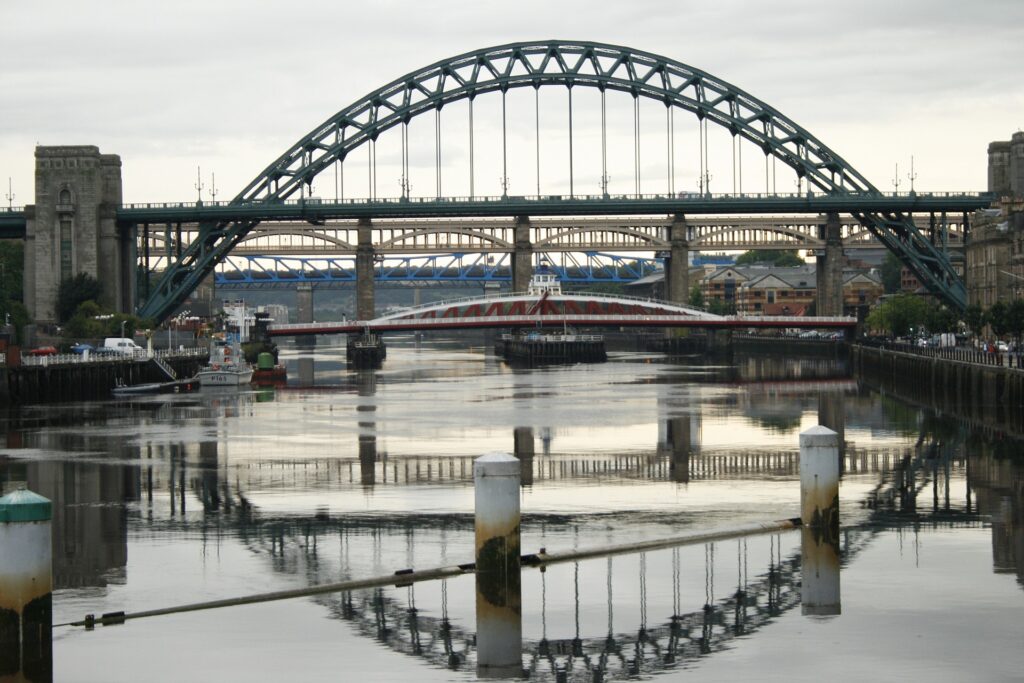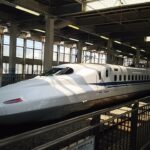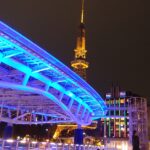Tyne and Wear has a robust public transportation infrastructure that offers citizens several ways to get around. The Metro, a system of above- and below-ground trains that offer a quick and effective means to travel around, is the most well-liked kind of public transportation in the area. Companies, like Go North East, Arriva, and Stagecoach run bus services that are also widely accessible. Additionally, there are a lot of taxi services in the area that provide door-to-door service. In addition to these services, several cycling and walking trails make it simple to get around on foot or by bike.
Metro system in Tyne and Wear: Basic information
In the north-east of England, there is a rapid transit network called the Tyne and Wear Metro. Sunderland, Gateshead, North and South Tyneside, and South Hylton are all served from Newcastle upon Tyne. Over 77 km of track and 60 stations make up the Metro, the majority of which are underground. On one of the few fully automated metro systems in the UK, there are no drivers on the trains. The system offers frequent service to commuters and tourists alike, with trains running roughly every 10-15 minutes throughout the day and every few minutes during peak hours. The Metro also provides park-and-ride facilities, connections to other public transportation providers, and the national train network.
The lines of the Tyne and Wear subway system
The Tyne and Wear Metro, affectionately known as the Metro, is a rapid transit and light rail system in North East England. It serves Newcastle upon Tyne, Gateshead, South Tyneside, North Tyneside and Sunderland in the Tyne and Wear region. The system is currently made up of two lines:
The Green Line
The Green Line runs from Newcastle Airport to South Hylton, spanning a total of 29 stations across a distance of 34.5 kilometers. The line was opened in stages between 1980 and 2002. It passes through city centers, residential areas, and industrial zones, making it an essential transport link for both commuters and recreational travelers.
Starting at Newcastle Airport, the Green Line runs southeast to South Gosforth. It then continues to Newcastle city center, passing through key stations such as Haymarket, Monument, and Central Station. From here, the line heads towards Gateshead and then Sunderland, serving stations such as Gateshead Stadium, Heworth, Pelaw, and Sunderland.
The Yellow Line
The Yellow Line follows a circular route, going from St James to South Shields via Whitley Bay, North Shields, and Tynemouth in the east, and Gateshead and Newcastle city center in the west. This line has a total of 60 stations and covers a distance of 45.3 kilometers.
The Yellow Line was Starting at St James, it runs east through Newcastle city center, serving stations such as Monument and Central Station. The line then heads towards the coast, serving stations in North Shields, Tynemouth, and Whitley Bay. From here, the Yellow Line loops back towards Newcastle, passing through Wallsend and Byker before returning to the city centre. The line then heads south, crossing the River Tyne via the Queen Elizabeth II Bridge. It serves Gateshead and then continues to South Shields, serving stations such as Hebburn, Jarrow, and Bede before terminating at South Shields.
Interchanges between the two lines are possible at several stations, including Monument, South Gosforth, and Pelaw, allowing passengers to switch lines with ease.
Map of Tyne and Wear Metro 2023 – Free Download in PDF

Click on the image and download the map of Tyne and Wear´s underground system for 2023
A fantastic way to navigate the city and discover the surrounding area is to use the Tyne and Wear Metro. You may easily plan your route and make sure you don’t miss any of the interesting spots with the help of a map of the Metro 2023, which is available for free download in PDF format. The lines, stations, and significant locations are all marked on this map, making it simple to navigate and maximize your travel time. It’s a fantastic tool for both residents and tourists, and it’s updated annually to guarantee accuracy.
Public transport tickets in Tyne and Wear: the Best types for travelers and actual prices
A single ticket, which entitles the holder to one trip on any Tyne and Wear Metro line, is the most basic ticket option. At each station, there are ticket machines that sell these tickets. The cost of a single ticket is dependent on the distance traveled and is available as a paper ticket or an electronic ticket.
A multi-journey ticket can be your best bet if you intend to travel more than once. Multi-journey tickets can be purchased in paper or electronic form and are valid for up to 10 trips during a week. For people who must travel frequently, these tickets are an excellent choice.
The ideal choice is a My Travel Pass for people who will frequently use Tyne and Wear’s public transit. This pass, which permits unlimited travel on any Tyne and Wear Metro service, is offered in a weekly or annual version. Additionally, it offers a number of advantages, including reduced airfare and access to special deals.
The Tyne and Wear Visitor Pass is the best choice for those who will only be in Tyne and Wear temporarily. Up to three days’ worth of unlimited travel on any Metro service is permitted with this card. Additionally, it offers discounts on a number of nearby attractions and activities.
Summary of fares for public transport in Tyne and Wear
- My Travel Pass offers unlimited travel on any Tyne and Wear Metro service and is available in weekly or annual versions with additional benefits.
- Single tickets are available as paper or electronic tickets
- Multi-journey tickets are valid for up to 10 trips during a week.
- The Tyne and Wear Visitor Pass provides discounts on nearby attractions and activities as well as up to three days of unlimited travel on any Metro service.
Timetables & Schedules for the Tyne and Wear Metro system
Operating hours for the Tyne and Wear Metro are 5.30 a.m. to 11.30 p.m. on weekdays and 7 a.m. to 11.30 p.m. on weekends. Trains typically run every 7 to 10 minutes during rush hours, which are from 7 to 9 a.m. and 4 to 6 p.m., while certain lines run even more frequently. Trains typically run every 12 to 15 minutes at other times, with some routes operating less frequently. There are 20-minute intervals between trains during the late-night weekend service.
What Are Other Options For Public Transportation In Tyne and Wear?
Tyne and Wear’s public transit system makes it simple to travel the area quickly and safely. Although the metro is the most widely used mode of public transportation in the region, there are still a number of other choices. You can choose the optimal route from one location to the next by being aware of all your possibilities.
bus transportation Tyne and Wear
The regional public organization known as Nexus controls and coordinates the bus services in Tyne and Wear. Nexus is responsible for ensuring that the bus services meet the needs of the community and for managing the timetables, routes, and fares.
The operation of the buses is usually contracted out to private companies, with Arriva North East, Go North East, and Stagecoach North East being the primary providers. The bus services in Tyne and Wear are extensive, covering all major areas within the county, including Newcastle, Sunderland, Gateshead, North Tyneside, and South Tyneside. The services are generally divided into local and express routes. Local services provide frequent stops, making them ideal for short trips within the city, while express services offer fewer stops and are more suitable for longer journeys.
Go North East’s bus lines are some of the most popular in Tyne and Wear. The company’s Angel 21 service, which runs between Durham and Newcastle via Gateshead, is particularly popular. The Stagecoach-operated X1 service, which offers a quick connection between Newcastle and Sunderland, is another heavily used line. Arriva’s Sapphire 22 service, running between Durham and Sunderland via Peterlee, is also a key route, as is their Coastliner 306 service, which provides a scenic route between Newcastle and the coastal town of Tynemouth.
For those traveling in and around the Newcastle and Gateshead Quayside areas, Go North East’s Quaylink Q1/Q2 service is a popular option. This service offers frequent stops at key locations such as the Baltic Centre for Contemporary Art and the Sage Gateshead.
How do the public TRAINS work in Tyne and Wear?
While the Metro mostly serves local transport within Tyne and Wear, it connects to the national rail network at several key locations, providing passengers with access to other cities.
Newcastle Central Station
- Located on the Green Line, it is a major transport hub that provides connections to cities across the UK, including London, Edinburgh, Leeds, and Manchester. LNER, CrossCountry, TransPennine Express, and Northern Rail are some of the train operators that serve it.
Sunderland Station
- It offers direct trains to Newcastle, Middlesbrough, and Hartlepool, among others. Northern Rail provides service to it.
Heworth Interchange
- Heworth Station, on the Yellow Line, is another significant interchange where passengers can connect to national rail services to destinations such as Middlesbrough and Carlisle.
How To Get From Newcastle International Airport (ncl) To The City Center With Public Transport?
If you choose to use the Metro, Airport Station is the closest station to the airport and is just a short distance away. As soon as you get to the station, you can buy a ticket from the ticket machines and board the Metro to get where you’re going. The Metro connects the airport to the city center, making it a simple and convenient way to get where you’re going.
The Airport Express bus provides another means of transportation from the airport to the heart of Newcastle. This bus leaves from outside the arrivals hall and travels directly to the city’s core, stopping at Central Station, Haymarket, and Monument along the way. The trip takes around 25 minutes, and tickets can be bought from the driver.
What kind of sightseeing do you have to do if you visit Tyne and Wear for the first time?
One of Tyne and Wear’s most recognizable landmarks is The Angel of the North, which is situated just outside of Gateshead. Built-in 1998, this artwork is 20 meters high and has come to represent the area. It’s a terrific location for photos and is close to both public transportation and a car.
Tynemouth’s Blue Reef Aquarium is a fantastic place to learn more about the ocean floor. The aquarium provides a pleasant and instructive experience for people of all ages with its assortment of exotic sea life, which includes anything from sharks to seahorses.
Another well-liked destination is Sunderland’s National Glass Centre. Along with interactive exhibits and demonstrations, it houses an impressive collection of glass and ceramic artwork. This is a must-see if you’re seeking for a distinctive cultural encounter.
Gibside, next to Rowlands Gill, is an excellent location for anyone wishing to explore the outdoors. It’s a wonderful way to spend the day with a stunning landscape and lots of outdoor pursuits, including walking, cycling, and horseback riding.
For history lovers, Newcastle upon Tyne’s Bessie Surtees House is a fantastic destination. It is a Grade I listed structure from the 17th century that has been conserved and brought back to its former splendor. It’s a fantastic way to learn about the culture and history of the city.
These are only a few of Tyne and Wear’s best tourist destinations. There are numerous activities available, whether you wish to engage in cultural experiences or simply enjoy the beautiful outdoors. Tyne and Wear has something for everyone, regardless of their hobbies.
What other metro systems are nearby in Tyne and Wear?
The closest one is the Tees Valley Metro, which is located in the Teesside area. Slightly further afield, the cities of Leeds and Manchester both have extensive tram networks – the Manchester Metrolink and the Leeds Supertram. Also, in the nearby country of Scotland, there is the Glasgow Subway, which is the third oldest underground metro system in the world. Lastly, the London Underground, the oldest and largest metro system globally, is a few hours away.
TAKE A LOOK AT THIS AMAZING VIDEO TOUR GUIDE ABOUT PUBLIC TRANSPORT IN TYNE AND WEAR
Summary of our tour guide for Tyne and Wear
As a longtime resident of Tyne and Wear, I know a lot about how to use our public transportation system. The Metro has been my lifesaver, making it easy for me to get to different parts of the area. It’s helped me get to work, see friends, and go to events. The buses have also been steady and have taken me to places that the Metro doesn’t reach. I’ve also liked taking the boat across the Tyne, which gives me a different view of our beautiful area. Overall, the way the different types of public transportation in Tyne and Wear are linked has made getting around easy and fun.
Top 5 FAQs and answers about Tyne and Wear public transport?
What kinds of transportation are offered?
- Buses, the Metro, ferries, and taxis are just a few of the many public transportation choices available in Tyne and Wear. Train and coach services are also offered for individuals who want to travel farther afield.
Where can I find maps and schedules?
- Timetables and maps are available on the Nexus website or at the Eldon Square Shopping Center’s Nexus Travelshop. Alternately, plans and maps are typically available at bus and Metro stops.
What is the price?
- Depending on the mode of transportation you choose, Tyne and Wear public transportation costs vary. The least expensive options include buses and the Metro, where one-way tickets start at just £1.20.
Do discounted tickets exist?
- Yes. If you qualify, you can get a variety of discounted passes in Tyne and Wear, including ones for the elderly and students. These passes are a fantastic way to save money and may be used on all public transportation systems.
Can people with disabilities use the transportation system?
- Yes. The public transportation system in Tyne and Wear is equipped with a number of features to help people with impairments and was created with accessibility in mind. All buses are wheelchair accessible, while elevators, ramps, and other facilities make it easier to utilize the Metro and railway stations.
Useful links







